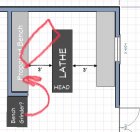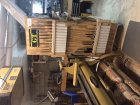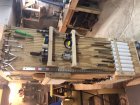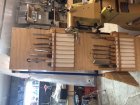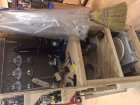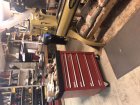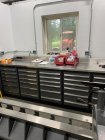Hello. I have mentioned in a few previous posts that I am currently in the process of running wiring, lights, etc. in a 1500 sq. ft. building that I am turning into a wood shop. Attached is a sectioned-off area of my shop that I want to put my lathe in. The lathe rectangle is to scale representing the overall footprint (as well as the bench on the right side wall). The headstock is on the open side of the room.
I am wondering what experienced wood turners would consider the minimum space needed around a full size lathe? All blocks on the picture are 1 foot so right now I have approximately 3’ planned for each side of the lathe. I have already built the left wall and the workbench on the right wall is in place. I have not built the workbench on the left and am starting to wonder if I should build that or just make storage shelves and not have a bench so that I can move the lathe over and have a little more room.
One other note--the right side wall has a window in it and my current thought is to have my back to the window when turning. My son thinks I should turn the lathe around, forego building a bench and use the left side wall for tool hanging with some higher shelves for blank and other storage. The window does not ever get direct sunshine coming in due to a 10' lean-to outside of the window and another building 20' away.
A third option would be to turn the lathe around but still put the bench in. I would appreciate any thoughts you all may have on this. Thank you.
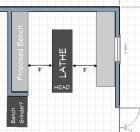
I am wondering what experienced wood turners would consider the minimum space needed around a full size lathe? All blocks on the picture are 1 foot so right now I have approximately 3’ planned for each side of the lathe. I have already built the left wall and the workbench on the right wall is in place. I have not built the workbench on the left and am starting to wonder if I should build that or just make storage shelves and not have a bench so that I can move the lathe over and have a little more room.
One other note--the right side wall has a window in it and my current thought is to have my back to the window when turning. My son thinks I should turn the lathe around, forego building a bench and use the left side wall for tool hanging with some higher shelves for blank and other storage. The window does not ever get direct sunshine coming in due to a 10' lean-to outside of the window and another building 20' away.
A third option would be to turn the lathe around but still put the bench in. I would appreciate any thoughts you all may have on this. Thank you.


